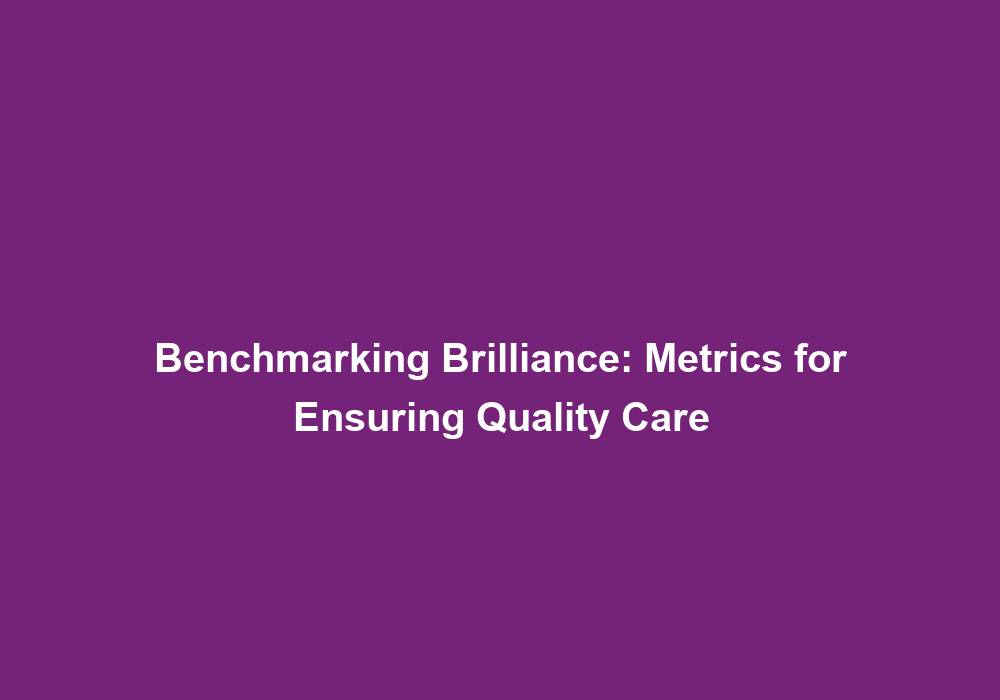Benchmarking Brilliance: Metrics for Ensuring Quality Care
In today’s ever-evolving healthcare industry, the pursuit of quality care has become a top priority for organizations worldwide. To achieve this, benchmarking has emerged as a valuable tool, enabling healthcare providers to measure their performance against industry standards and best practices. By utilizing various metrics, healthcare organizations can identify areas for improvement, optimize processes, and ultimately enhance the quality of care delivered to patients.
Introduction to Benchmarking in Healthcare
Benchmarking can be defined as the process of comparing and measuring an organization’s performance metrics against those of its peers or industry standards. In the healthcare sector, benchmarking helps identify and apply best practices, leading to improved patient outcomes, enhanced patient satisfaction, and more efficient resource allocation.
Types of Benchmarking
To ensure quality care, healthcare organizations can employ different types of benchmarking, each serving a unique purpose:
-
Internal Benchmarking: Internal benchmarking involves comparing performance metrics within the same organization, such as different departments or facilities. This type of benchmarking helps identify areas where improvement is needed and encourages collaboration and knowledge sharing across the organization. For example, a hospital may compare the patient satisfaction scores of its various departments to identify which areas need improvement and implement strategies to enhance patient experience.
-
Competitive Benchmarking: In this approach, healthcare organizations compare their performance against direct competitors or industry leaders. By analyzing the practices and outcomes of successful organizations, benchmarks can be set to drive continuous improvement and achieve a competitive edge. For instance, a healthcare organization may compare its clinical outcomes, such as mortality rates and infection rates, with those of top-performing hospitals in the region to identify areas for improvement and implement strategies to enhance patient safety and quality of care.
-
Functional Benchmarking: This type of benchmarking focuses on specific processes or functions within healthcare organizations. By comparing these processes with those of other industries, valuable insights and innovative strategies can be gained, leading to improved performance and quality care. For example, a hospital may benchmark its efficiency metrics, such as length of stay and patient throughput, with those of a high-performing manufacturing company to identify areas for improvement and streamline processes.
-
External Benchmarking: Here, healthcare organizations compare their performance against industry standards and best practices. This type of benchmarking allows organizations to assess their performance on a broader scale and identify areas where they may be falling short or excelling. For instance, a healthcare organization may compare its patient satisfaction scores with national benchmarks to determine how well it is meeting patient expectations and implement strategies to enhance patient experience.
Key Metrics for Ensuring Quality Care
To effectively benchmark and measure the quality of care, specific metrics should be considered. These metrics provide a quantitative and qualitative perspective on various aspects of healthcare delivery, enabling organizations to identify areas for improvement and monitor progress over time. Some essential metrics that healthcare providers should consider include:
-
Patient Satisfaction Scores: Measuring patient satisfaction is crucial in evaluating the quality of care provided. Surveys and feedback mechanisms can be utilized to gather patient input, enabling healthcare organizations to identify areas where improvements can be made to enhance patient experience. For example, hospitals can use patient satisfaction scores to identify specific areas, such as communication with healthcare providers or responsiveness to patient needs, that require improvement.
-
Clinical Outcomes: The measurement of clinical outcomes, such as mortality rates, infection rates, readmission rates, and patient complications, is vital for assessing the effectiveness of medical interventions and treatments. Comparing these outcomes to national or international benchmarks can help identify areas for improvement and ensure the delivery of high-quality care. For instance, hospitals can track their infection rates and benchmark them against national averages to identify areas for improvement and implement infection control protocols.
-
Patient Safety Indicators: Patient safety is a critical aspect of quality care. Metrics such as the number of adverse events, medication errors, falls, and hospital-acquired infections can provide insights into the effectiveness of safety protocols and identify areas that require attention. For example, hospitals can track medication errors and benchmark them against industry standards to identify areas for improvement and implement medication safety protocols.
-
Efficiency Metrics: Evaluating the efficiency of healthcare processes is essential for optimizing resource utilization and minimizing waste. Metrics such as length of stay, wait times, and patient throughput can help identify bottlenecks and streamline processes to enhance the overall patient experience. For instance, hospitals can track their length of stay metrics and benchmark them against industry standards to identify areas for improvement and implement strategies to reduce patient waiting times.
-
Cost Metrics: While maintaining quality care, healthcare organizations must also consider the cost implications. Metrics such as cost per patient, cost per procedure, and revenue per bed can help identify areas of inefficiency and support cost-saving initiatives without compromising the quality of care. For example, hospitals can track their cost per patient metrics and benchmark them against industry averages to identify areas for cost reduction and implement strategies to improve cost-effectiveness.
Implementing Benchmarking Practices
To effectively implement benchmarking practices and ensure continuous improvement in quality care, healthcare organizations should follow these steps:
-
Define Clear Objectives: Clearly define the desired outcomes and metrics to be benchmarked. Determine the specific areas of care to focus on and the goals to be achieved. For example, a hospital may set objectives to improve patient satisfaction scores and reduce medication errors.
-
Identify Comparable Organizations: Select organizations or facilities with similar characteristics to allow for meaningful comparisons. Consider factors such as size, patient demographics, and specialty focus. For instance, a hospital specializing in pediatric care may benchmark its performance against other pediatric hospitals with similar patient populations.
-
Collect and Analyze Data: Gather relevant data from both internal and external sources. Ensure the accuracy and reliability of the data and analyze it to identify gaps, strengths, and areas for improvement. For example, hospitals may collect data on patient satisfaction scores from surveys and analyze it to identify specific areas for improvement.
-
Set Targets and Develop Action Plans: Based on the benchmarking results, establish realistic targets and develop action plans to address identified areas for improvement. Engage stakeholders and allocate necessary resources to support the implementation of improvement initiatives. For instance, hospitals may set targets to reduce infection rates and develop action plans to enhance infection control protocols.
-
Monitor Performance and Adjust: Continuously monitor performance against benchmarks and track progress over time. Regularly review and adjust action plans based on feedback and new insights to ensure sustained quality improvement. For example, hospitals may regularly review patient satisfaction scores and adjust action plans based on feedback to continuously enhance patient experience.
Conclusion
Benchmarking has become an invaluable tool for healthcare organizations striving to deliver quality care. By utilizing various metrics and comparing their performance against industry standards and best practices, healthcare providers can identify areas for improvement, optimize processes, and enhance patient outcomes. Through the systematic implementation of benchmarking practices, healthcare organizations can continuously improve the quality of care they provide, ensuring brilliance in healthcare delivery.






